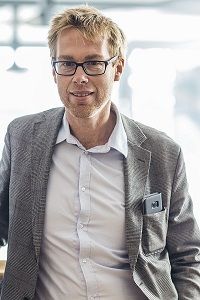Ella Einarsen and Christian Heina are students of IT-Högskolan in Gothenburg. Starting from September they are working on their internship project at Sigma Technology—they are developing an Augmented Reality (AR) application for Android.
Hi, Ella and Christian. You are about to embark on an exciting journey of discovering new fresh technologies.
Can you tell us about your background and why you chose IT?
Ella: We are studying Android and web applications development at IT-Högskolan (higher vocational school). Now we are almost done with our training that ends with this three-month internship at Sigma Technology.
Christian: I find IT exciting because it doesn’t require many resources to build something new. You can create an application whenever you want using your knowledge and a laptop.
How did you come to the idea of the internship?
The idea for the project came when we had an interview with Johnny Fägersten. He came to our school regarding LIA program (LIA or Lärande i Arbete, Learning while Working, is a program helping students to combine theory with practice, while they are out at the workplace). During our interview, he simply suggested us exploring new AR technology for app development. We didn’t hesitate long! 🙂
What will make the app you develop unique?
The AR app for Android will replace thousands of manuals and put them directly in your phone when you hover its camera over an object. The instructions will show up from DocFactory, enterprise content management system in the cloud, developed by Sigma Technology.
So you will be able to scan whatever you want, right?
Theoretically, yes 🙂 But now we start with a Volvo car model. The 3D scanning technology is very sensitive. It reacts to round shapes, light, sunbeams, background objects. There is a lot to work with now.
What helps you in your work? Do you use some existing solutions?
Christian: We have been testing different things. Now we are using a mathematic library for just recognizing the objects. The library helps with mathematic analysis distinguishing points and contours.
Ella: There is a bunch of external libraries, but part of them are not open or are not tailored for Android or Java that we need to use.
Christian: Moreover, the majority of those libraries use some type of code for recognizing objects and we aim at achieving objects recognition just the way there are, without any codes, but with 3D scanning. And there are no solutions available.
Ella: Yes, we have to learn and understand a lot. We almost need to develop AR technology ourselves.
That sounds like a real challenge! Do you think that this is possible during these three months?
Christian and Ella reply almost at the same time: Yes, sure! We will have a result, though we don’t know yet how it will look like. Something is definitely on the way.
What knowledge helps you?
Christian: Well, it is still programming, so we use our knowledge from app development.
Ella: Yes, on the base level the technologies are very similar—it is a lot of mathematics. Augmented Reality is new for us, so we research a lot! (Ella chuckles) We haven’t googled so much in our lives before.
Christian: Our biggest challenge remains to recognize objects in an efficient way. We work quite a lot ourselves.
How does it feel after a few weeks?
Both Christian and Ella agree that it feels quite well.
Then Ella reflects:
You actually feel the difference between school labs and this project. While, in the high school, we work on short-term projects that cover some particular part of the knowledge or technology, during this project we do all the job. From initial research to end product. It feels fantastic!
Christian continues:
It gets even more exciting when you are working with such new technologies as AR, which is still in the process of development and is very fresh.
We have a big challenge, but we will try our best!
Johnny Fägersten, Unit Manager at Sigma Technology Solutions:

When we developed DocFactory, our motivation was to make information available to users anywhere on any device when they need it.
I believe that Ella and Christian’s project will take it one step further making information search as easy as it has never been before. The user will just need to point the phone camera towards the object and get the essential facts that are needed. No PDFs or manuals anymore.
We are working with Augmented Reality on different projects and for different industries. I’m looking forward to seeing how this project will turn up.
For more information, please contact Johnny Fägersten johnny.fagersten@sigmatechnology.com
